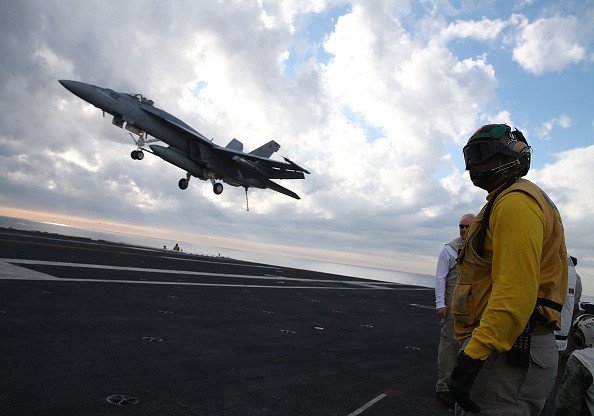Beijing Admits Chinese Jet Fighter Technology Inferior to Western Warplanes, Says Report
| Carlos Castillo | | Jan 31, 2016 10:56 AM EST |
(Photo : Photo by Mark Wilson/Getty Images) A F18 Super Hornet prepares to land on the deck of the USS Eisenhower off the coast of Virginia, December 10, 2015 in the Atlantic Ocean. The Chinese Ministry of Defense admitted recently that there is a "definite gap" between Chinese military technology and some developed countries.
Chinese jet fighters are likely to be at a disadvantage in the event of an aerial confrontation with Western combat aircraft -- or even fighters from US ally Japan -- over the East and South China Seas, foreign and Chinese aviation experts have said.
In a brief statement released to Reuters recently, the Chinese Ministry of Defense admitted that there is a "definite gap" between Chinese military technology and some developed countries. The statement said Beijing will continue to strengthen China's armed forces.
Like Us on Facebook
Douglas Barrie of the International Institute of Strategic Studies in London says the country's fighter jet engine technology, in particular, lags behind those of Western jet engine manufacturers such as Pratt and Whitney, General Electric (GE.N) and Rolls Royce (RR.L).
Barrie has in the past suggested that the frame of China's fifth generation stealth fighter, the Chengdu J-20, borrows heavily from the MiG 1.42, a Russian prototype designed in the 1980s but abandoned by the Kremlin sixteen years ago.
Sheer Numbers
The technology gap has led many experts to suggest that the Chinese People's Liberation Army (PLA) Air Force will have to rely on sheer numbers to overwhelm Western combat aircraft in the event of a dogfight over contested territories in Asia.
US defense expert Dave Majumdar told the state-run Russian news agency Sputnik in September last year that -- while US jet fighters are superior to their Chinese counterparts -- China is building a vast number of fighter aircraft.
He likewise points out that US warplanes require bases or tankers from which they could refuel, a necessity which could render America's superior jet fighters ineffectual in an all-out air air contest against China.
"If there were to be a war in the Western Pacific, the massive air battles that many envision are not likely to take place because the United States and our allies have few bases in the region to host tactical fighters like the F-35," says Majumdar, who adds that China is likely to destroy those bases should a conflict erupt between the two countries.
The technology divide is nevertheless is a thorn in China's side as an unnamed Chinese military expert familiar with Beijing's defense policies admitted to Reuters that Chinese fighters do not perform as well as US fighters.
Closing the Gap
Experts say much of the disparity between Chinese and US jet fighter technology is a consequence of Western restrictions on arms trading with China, which prohibit the sale of Western engines for military use. The restrictions have forced Chinese engineers to rely on their own designs or borrow from engine technology that Russia has agreed to sell.
And so far, Chinese designs have fallen short of those produced by US experts. China's best warplane engine, the WS-10A Taihang, which was designed by engineers at the Shenyang Aeroengine Research Institute, doES not produce enough thrust and require frequent repairs, sources tell Reuters.
"They are trying to improve the Taihang, but reliability is a major problem," says one source.
The same sources also claim that the Chinese J-20 and J-21 stealth fighters are unable to fly at supersonic speeds like the US F-22 Raptor without using afterburners, which make them visible on radar.
These problems are not lost on China's military establishment, which has seen a rapid increase in the pace of Chinese jet engine research and development. The Shanghai-based aerospace consulting firm, the Galleon group, says China will spend an estimated $300 billion on civil and military aircraft engine programs over the next two decades alone.
China is, in fact, advancing its aviation technology at breathtaking pace. The J-20 first took to the air in January 2011, and officially entered the early stages of production last yeAR.
In comparison, it took the US -- which has more experience building state-of-the-art fighter aircraft -- nearly 20 years to develop the F-35.
TagsPeople's Liberation Army Air Force, Chengdu J-20, jet fighter
©2015 Chinatopix All rights reserved. Do not reproduce without permission
EDITOR'S PICKS
-

Did the Trump administration just announce plans for a trade war with ‘hostile’ China and Russia?
-

US Senate passes Taiwan travel bill slammed by China
-

As Yan Sihong’s family grieves, here are other Chinese students who went missing abroad. Some have never been found
-

Beijing blasts Western critics who ‘smear China’ with the term sharp power
-

China Envoy Seeks to Defuse Tensions With U.S. as a Trade War Brews
-

Singapore's Deputy PM Provides Bitcoin Vote of Confidence Amid China's Blanket Bans
-

China warns investors over risks in overseas virtual currency trading
-

Chinese government most trustworthy: survey
-

Kashima Antlers On Course For Back-To-Back Titles
MOST POPULAR
LATEST NEWS
Zhou Yongkang: China's Former Security Chief Sentenced to Life in Prison

China's former Chief of the Ministry of Public Security, Zhou Yongkang, has been given a life sentence after he was found guilty of abusing his office, bribery and deliberately ... Full Article
TRENDING STORY

China Pork Prices Expected to Stabilize As The Supplies Recover

Elephone P9000 Smartphone is now on Sale on Amazon India

There's a Big Chance Cliffhangers Won't Still Be Resolved When Grey's Anatomy Season 13 Returns

Supreme Court Ruled on Samsung vs Apple Dispute for Patent Infringement

Microsoft Surface Pro 5 Rumors and Release Date: What is the Latest?










